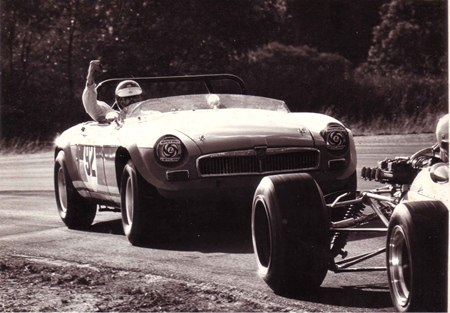At this time of year we look back at what happened in 2012, and then it just goes on from there – as far back as you can remember. For me, I was reminded of the saga of SuperBee, a race car I built in 1968, which is still racing today. The reminder came from a magazine in Australia (The BMC Experience) asking for details of SuperBee as they wished to feature it. Wow! What a blast that was.
Turn the clock back to 1968 – what were you doing then? Some of you may not even have been born, but I was in the UK following a dream. A dream of building the fastest MGB in Australia.
 Get out of my way!
Get out of my way!
You have to remember that in those years I was an “MG man” through and through. I had started with MG TC’s, through MG TD’s to MGA’s and had begun racing with an A in 1965. I was a member of the MG Car Club, and for me, there was no other marque.
I had read of the factory competition parts for MGB’s and when in the UK, I knew this was my chance to purchase ‘go faster’ bits and return to Australia to build a racing MGB. I also had an Aussie friend in the UK at the same time, who was prepared to get the parts for me and issue somewhat dodgy invoices, should the Australian Customs query the alleged purchase price.
On my return to Australia, I set to and found an MGB shell from a car that had been stolen, stripped and torched. This became the first of the SuperBee series and in 1969 was certainly the quickest MGB in the Queensland state of Australia.
In 1970 I was offered a contract by British Leyland in Australia to race for them and SuperBee was cleaned up and repainted in British Leyland blue (which was actually a Fiat colour). As this car looked much better than SuperBee 1, it was called SuperBee 2.
SuperBee 2 really set the Australian tracks alight and it was written up in the media in 1970 as the fastest MGB in Australia, and indeed it was, having never been beaten by any other race MGB. In fact it scared many other categories as well.
We raced in what was called the Marque Sports series, but we were being beaten by an alloy-headed 3.4 litre Austin Healey. SuperBee 2 needed more power.
So in 1971, the car, now called SuperBee 3, made its appearance. The engine for the car was the world’s first twin overhead cam MGB. We set lap records at every circuit but had a finishing rate of only 50 percent as the T/C engine progressively broke everything from the flywheel bolts to the rear axles.
In 1972 the rules for the sports car class were changed and SuperBee 3 was outlawed. The car that British Leyland claimed was the fastest MGB in the world was put in the shed.
I sold it after a couple of years to twin brothers Peter and John McCabe who returned it to a pushrod engine, but Peter was killed in a racing accident (not in SuperBee) and their mother extracted a promise from John that he would not race the car. So it returned to another shed, where it stayed for the next 34 years!
John died in 2008 and his widow advertised the car for sale and Ian Rogers, an enthusiast in Australia, bought it. By then, after 34 years of sitting, it needed restoration and that he has done, with some advice from me here in Thailand.
It is not often that a race car sits in a shed for 30 plus years, especially one with the pedigree of SuperBee, the fastest MGB in the world (in 1971) and gets brought back to its former glory. I have been honored in my dotage. And what a great reminiscence!




